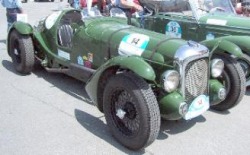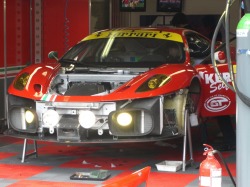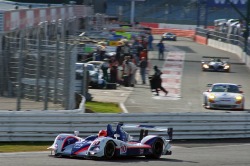The 24 Hours of Le Mans is the oldest and most prestigious endurance race for sports cars in the world. The race first ran in 1923 near the town of Arnage and, apart from war years and a strike in 1936, has run every year since.
The Past

The 24 Hours of Le Mans first ran on the 26th and 27th May 1923 and was held on public roads in Le Mans and surrounding villages, in the Sarthe region of France. The event was designed to test the endurance of both driver and machine over the course of 24 hours, with the winner having covered the greatest distance in that time. Pre- war races were dominated by British, French and Italian drivers driving the likes of Bugatti, Bentley and Alfa Romeo.
After a break of 10 years following World War Two, and the necessary rebuilding of France following the war, the race resumed in 1949. Interest in the event grew in the post-war years with marques such as Jaguar, Aston Martin, Ferrari and Mercedes-Benz regularly competing at the Circuit de Sarthe.
The history of the event is not without it’s fair share of tragedy. An accident in 1955 resulted in the death of more than 80 people when a race car crashed into the crowd of spectators. Cars of the time were still based on production road cars but were achieving speeds over 200mph on the Mulsanne, a 5km+ straight.
In 1966, Ford entered the event with the GT40 and would dominate for the next four years, paving the way for the era of the prototype. Evocative cars such as the Porsche 917 and Lola T70 belong to this period, France were successful with wins for Renault and Matra-Simca.
Cars had become faster and more powerful. Group C was introduced following the fuel crises of the 1970s to encourage fuel efficiency and limit power by encouraging car designers to design their cars to meet strict fuel restrictions. This encouraged manufacturers to develop more efficient engines and aerodynamics and, rather than restricting top speed, arguably led to higher speeds being achieved at the circuit. Porsche dominated, while Jaguar, Mercedes-Benz and Japanese prototypes from Nissan, Toyota and Mazda all raced during this period.
In 1990 following an FIA (Federation Internationale de l’Automobile) ruling that no straight should exceed 2km, two chicanes were introduced to the Mulsanne Straight. This finally addressed the issue of top speed; cars by now were regularly exceeding 240mph.
The 1990’s saw the return of the supercar, the rules favouring production orientated GT cars. McLaren, Porsche, Mercedes-Benz and Panoz all developed cars for the GT class at Le Mans. The end of the decade saw the return of the prototype.
After a break of 10 years following World War Two, and the necessary rebuilding of France following the war, the race resumed in 1949. Interest in the event grew in the post-war years with marques such as Jaguar, Aston Martin, Ferrari and Mercedes-Benz regularly competing at the Circuit de Sarthe.
The history of the event is not without it’s fair share of tragedy. An accident in 1955 resulted in the death of more than 80 people when a race car crashed into the crowd of spectators. Cars of the time were still based on production road cars but were achieving speeds over 200mph on the Mulsanne, a 5km+ straight.
In 1966, Ford entered the event with the GT40 and would dominate for the next four years, paving the way for the era of the prototype. Evocative cars such as the Porsche 917 and Lola T70 belong to this period, France were successful with wins for Renault and Matra-Simca.
Cars had become faster and more powerful. Group C was introduced following the fuel crises of the 1970s to encourage fuel efficiency and limit power by encouraging car designers to design their cars to meet strict fuel restrictions. This encouraged manufacturers to develop more efficient engines and aerodynamics and, rather than restricting top speed, arguably led to higher speeds being achieved at the circuit. Porsche dominated, while Jaguar, Mercedes-Benz and Japanese prototypes from Nissan, Toyota and Mazda all raced during this period.
In 1990 following an FIA (Federation Internationale de l’Automobile) ruling that no straight should exceed 2km, two chicanes were introduced to the Mulsanne Straight. This finally addressed the issue of top speed; cars by now were regularly exceeding 240mph.
The 1990’s saw the return of the supercar, the rules favouring production orientated GT cars. McLaren, Porsche, Mercedes-Benz and Panoz all developed cars for the GT class at Le Mans. The end of the decade saw the return of the prototype.
The Present

1999 saw Mazda, Porsche and Audi and BMW all competing in the prototype class for top honours. After the event many major manufacturers withdrew citing increased costs in competing in the event. Only Audi remained with their R8, with which they were to dominate. With the exception of 2003 and Bentley (Audi’s sister company), Audi have won the event every year since 2000. Audi’s R8 was replaced by the R10, a diesel-powered monster, in 2006, and have continued their success.
Although until now we’ve concentrated on the winners, there are currently four classes of cars competing at Le Mans, each competing for their own class honours.
LMP1 and LMP2 contain the prototypes, the two classes are divided by weight and power output. The LMP2 category, though limited in power, have an advantage in weight and enable teams, perhaps without the budget of teams such as Audi, to compete at a similar level.
The GT1 and GT2 classes are for production-based GT cars and are also split by power and weight. The GT1 class today contains the likes of Aston Martin, Ferrari, the Chevrolet Corvette and the Dodge Viper. In recent years the GT2 category has been dominated by Porsche with the venerable 911 and it’s variants.
Although until now we’ve concentrated on the winners, there are currently four classes of cars competing at Le Mans, each competing for their own class honours.
LMP1 and LMP2 contain the prototypes, the two classes are divided by weight and power output. The LMP2 category, though limited in power, have an advantage in weight and enable teams, perhaps without the budget of teams such as Audi, to compete at a similar level.
The GT1 and GT2 classes are for production-based GT cars and are also split by power and weight. The GT1 class today contains the likes of Aston Martin, Ferrari, the Chevrolet Corvette and the Dodge Viper. In recent years the GT2 category has been dominated by Porsche with the venerable 911 and it’s variants.
The Future

Issues outside of the sport look set to continue to shape the future of Le Mans, with issues such as climate change being acknowledged by manufacturers in the sport. Audi’s diesel-powered R10 is a case in point; demonstrating fuel efficiency not only sells cars but gives the manufacturer a key advantage in the race. Aside from diesel, bio-ethanol fuelled cars have also competed in the race.
In 2011, the ACO, the organising body of the race plan to limit the LMP1 category to closed-top cars to encourage brand recognition. Further changes down the order are planned in order to reduce costs.
Whether the ACO are able to recapture the heady days of the Ford GT40, or the spectacle of the Group C racers in the 1980’s, remains to be seen!
In 2011, the ACO, the organising body of the race plan to limit the LMP1 category to closed-top cars to encourage brand recognition. Further changes down the order are planned in order to reduce costs.
Whether the ACO are able to recapture the heady days of the Ford GT40, or the spectacle of the Group C racers in the 1980’s, remains to be seen!

